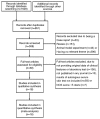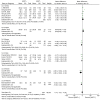Association of positive and negative autologous serum skin test responses with clinical features of chronic spontaneous urticaria in Asian patients: A systematic review and meta-analysis
- PMID: 30906452
- PMCID: PMC6425266
- DOI: 10.3892/etm.2019.7266
Association of positive and negative autologous serum skin test responses with clinical features of chronic spontaneous urticaria in Asian patients: A systematic review and meta-analysis
Abstract
Previous studies on the correlation between positive autologous serum skin test (ASST) responses and the clinical features of patients with chronic spontaneous urticaria (CSU) have provided conflicting results. To evaluate the significance of ASST responses in CSU, a variety of databases were searched from inception to March 2018 to identify relevant studies on CSU. Data were analyzed with use of the Cochrane Collaboration's Review Manager 5.2. Multiple relevant factors of CSU were evaluated by calculating the weighted mean difference, odds ratio and 95% confidence interval. The results indicated that CSU cases with positive ASST responses had higher urticaria activity scores and higher levels of total serum immunoglobulin E than CSU cases with negative responses in the ASST. In addition, a positive ASST response was more likely to be accompanied with the presence of thyroid autoantibodies and angioedema. An increased prevalence of CSU was identified in females, who were more likely to have a positive response in the ASST. It was also indicated that a greater incidence of positive ASST responses was present in CSU patients as compared with that in healthy controls. No statistically significant differences were obtained between positive and negative ASST responses with regard to age and duration of disease. Based on these results, it was concluded that the ASST provides an effective means of predicting urticaria activity and recurrence in CSU patients.
Keywords: angioedema; autologous serum skin test; chronic urticaria; meta-analysis; urticaria activity score.
Figures










References
-
- Fraser K, Robertson L. Chronic urticaria and autoimmunity. Skin Therapy Lett. 2013;18:5–9. - PubMed
-
- Feng L, Song ZQ, Hao F. Application of autologous serum skin test in chronic urticaria: Current advances. J Clin Dermatol. 2011;08:508–510.
LinkOut - more resources
Full Text Sources
